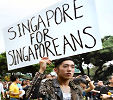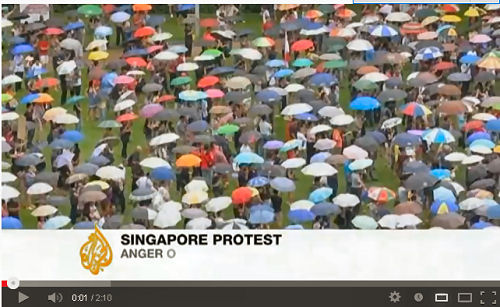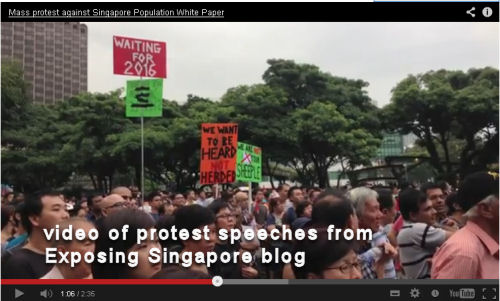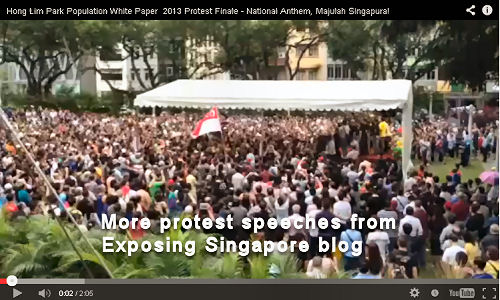Singaporeans mass demonstration against mass immigration
 5000 Singaporeans demonstrated Feb 18, 2013 against mass migration blaming influx for infrastructure strains, record-high housing and transport costs and competition for jobs. Government plans for even higher immigration have been greated with cynicism, distress and mass protest. Three video-links inside, two indie-media.
5000 Singaporeans demonstrated Feb 18, 2013 against mass migration blaming influx for infrastructure strains, record-high housing and transport costs and competition for jobs. Government plans for even higher immigration have been greated with cynicism, distress and mass protest. Three video-links inside, two indie-media.
 On Feburary 16 about 5000 Singaporeans grathered at the Speakers' Corner at Hong Lim Park to voice their anger at the government's announcement of a plan to raise the population with mass immigration. The government excuse was, shamefully and predictably, 'the aging population'.
On Feburary 16 about 5000 Singaporeans grathered at the Speakers' Corner at Hong Lim Park to voice their anger at the government's announcement of a plan to raise the population with mass immigration. The government excuse was, shamefully and predictably, 'the aging population'.
Like Australian governments, rather than face facts about inevitably rising energy costs and the need for stable populations and less production to adjust to these limits, power elites wherever they can get away with it, try to make the public pay to keep them in the style of opulence to which they have become accustomed.
Protesters said how they had paid their taxes and worked hard, and that Singapore should be for Singaporeans. "We were not given anything for free here," said one woman.
Reading between the lines, one can see that their fear is that competition for housing and jobs will raise rents and lower wages.
Singaporeans rarely protest because they fear that displeasing their government might see them without housing. The government owns almost all the housing in Singapore. Since it is a dictatorship, that makes its tenants and citizens insecure. It takes a lot of guts to protest in Singapore, so the situation must be pretty awful. See, on dictatorship and penalties for poltical blogging: http://singaporedissident.blogspot.com.au/2012/01/singapore-dictatorships-look-good-till.html and http://exposingsingapore.wordpress.com/2013/02/ . It is also very hard to blog politically for citizens there due to government surveillance. For this reason Candobetter.net would like to inform Singaporeans that we welcome and protect comments and articles from Singaporeans on this matter and any others that fit in with our philosophy of reform in democracy, environment, population, land use planning and energy policy
Singapore and Australia - two islands with limited living space
Singapore is a tiny island which for years has relied on a daily influx of workers from Malaysia to supplement its workforce. Those workers have no rights of citizenship, nor residence. Each night the go home across the border. Citizenship in Singapore means the right to housing, eduation, social services and work. These conditions were extremely hard won. British invasion disorganised and dispossessed and turned into laborers a stable self-supporting population of localised clans and tribes. After the British left, Singaporeans faced poverty and overpopulation. Now, as they are getting some sense of stability, their government is trying to pull the British recolonisation trick. That's the one we deal with in Australia, where self-government is never a real possibility, since the corporates pull the strings in federal and state parliaments and state parliaments control local government.
The government has tried to quell anger by saying that only half the new immigrants will be given citizenship, but that is hardly reassuring.

Ordinary Australians can sympathise with ordinary Singaporeans. Singapore has very limited land, a population of about 3.3m (plus 2 million non-citizens) but a higher GDP than Australia, which has a population of 22 million. Australia also has limited land because, although it is a big continent, much of it is desert, lacks water, has high temperatures and cannot support much life. Australia's manufacturing industry has degenerated in the past 50 years (due to government policy) leaving it largely a commodity producer, relying on the export of minerals and agricultural product, and, more and more on the sale of citizenship via the backdoor through land-sales. Recent changes to workers' rights and conditions leave Australian citizens unprotected against low-paid immigrant workers. (See http://candobetter.net/?q=RightsAtWork).
Australia: Political disorganisation through mass immigration - an old colonial government trick
Australians have been greatly disorganised by mass immigration since the second world war, leaving the population in a condition where it cannot really organise politically. Although many Australians would probably like to have mass protests against high immigration, the society lacks the cohesiveness to do so. Singaporians seem to have retained enough commonality with each other to be able to organise politically, despite the dictatorship nature of the government. Maybe that is what the government is really afraid of. It may be following Australia's recipe for political and disorganisation via mass immigration.
The place where the peoples' protest took place, Speakers' Corner, created only in 2000, was the first official location for democratic speech in Singapore. No-one was expected to take it seriously.
“It’s a big red flag and they cannot go on with business as usual, with their old way of doing things of letting it blow over and letting emotions run their course,” said Terence Lee, who teaches politics at National University of Singapore. “This is not an emotional hump. I won’t be surprised if significant changes happen at the ballot box in 2016.”
The rally increases pressure on the government to slow an influx of immigrants that has been blamed for infrastructure strains, record-high housing and transport costs and competition for jobs. Singapore’s population has jumped by more than 1.1 million since mid-2004 to 5.3 million and may reach 6.9 million by 2030, based on the proposal. That stoked social tensions and public discontent that is weakening support for Lee’s People’s Action Party. [See: Shamim Adam, "Singapore Protest Exposes Voter Worries About Immigration," Feb 18, 2013, Bloomberg.com http://www.bloomberg.com/news/2013-02-16/singaporeans-protest-plan-to-increase-population-by-immigration.html]
 Singaporeans get on well with Australians and, ironically, many have migrated here to get away from the population pressure in Singapore. Some Singaporean friends of Candobetter.net express surprise at how our governments seem to be inviting the same pressure here. Our Federal government under the National Foreign Investment Review Board laws has a special arrangement with Singapore to preference Singaporeans buying property here and State governments have done deals with the Singaporean dictatorship by giving public land away to Australand (more than 50% Singapore government owned) and permission to develop housing estates on it and resell to overseas buyers. An example is the housing estate at Royal Park in Melbourne, about which there were many public protests.
Singaporeans get on well with Australians and, ironically, many have migrated here to get away from the population pressure in Singapore. Some Singaporean friends of Candobetter.net express surprise at how our governments seem to be inviting the same pressure here. Our Federal government under the National Foreign Investment Review Board laws has a special arrangement with Singapore to preference Singaporeans buying property here and State governments have done deals with the Singaporean dictatorship by giving public land away to Australand (more than 50% Singapore government owned) and permission to develop housing estates on it and resell to overseas buyers. An example is the housing estate at Royal Park in Melbourne, about which there were many public protests.
Singapore: "A small crowded island"
Another problem that Singaporeans share with Australians is that the government is trying to countermand the obvious decision by citizens to reduce their family size in response to the discomforts of population increase and the associated increased cost of living
http://www.sustainabilityinstitute.org/dhm_archive/index.php?display_article=vn210singaporeed
Where Lee Kuan Yew tried to get educated women to have three children, the government is now trying to boost numbers with high immigration, as in Australia.
Singaporeans invited to send comments and articles to candobetter.net
Candobetter would welcome input - in the form or articles and comments - from our friends in Singapore on this matter. At the moment there are problems posting on this site if you do not use Explorer. We are very sorry (and embarassed because this is an open source site). If you experience real problems, please email us via the contact link at the top left of our page (http://candobetter.net/?q=contact), labelling your contribution, "Comment or article for CDB. We do hope soon to fix our upgrade problems.

Recent comments